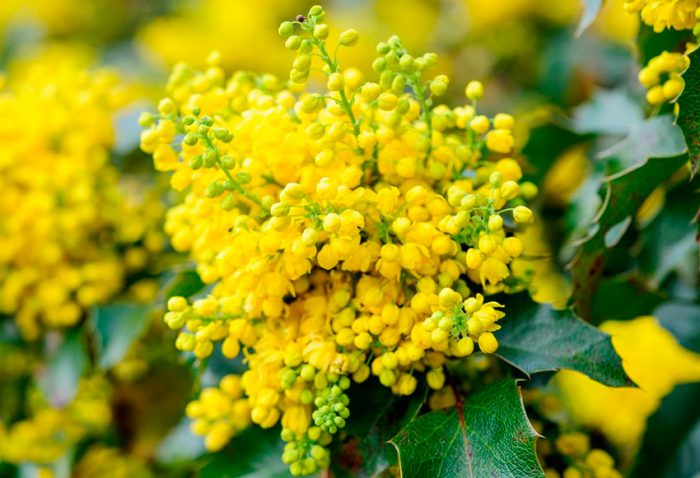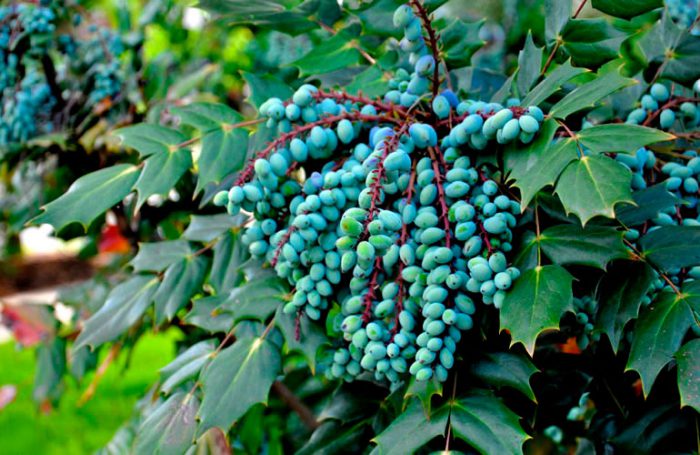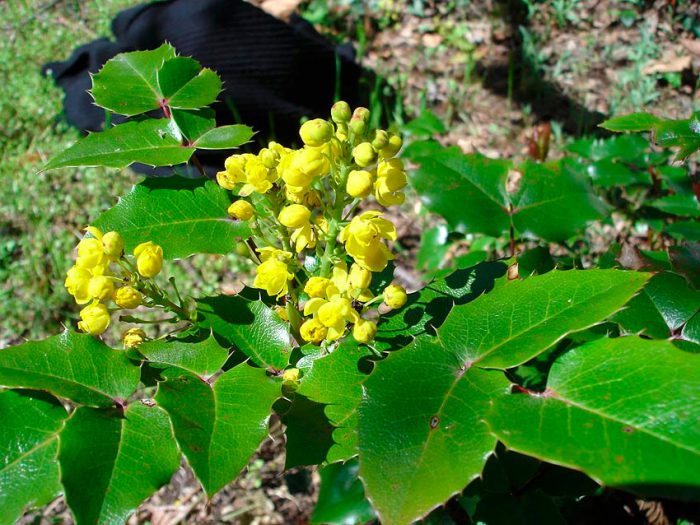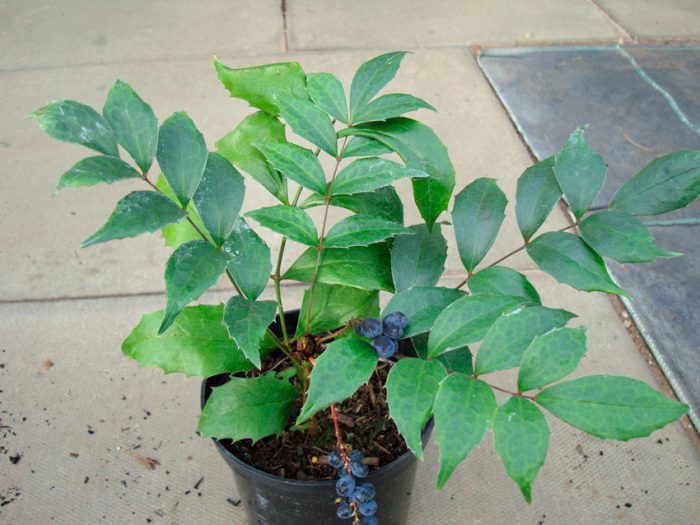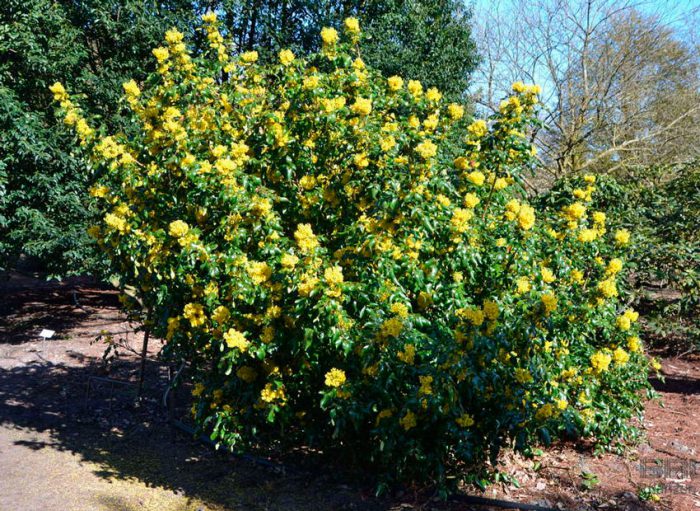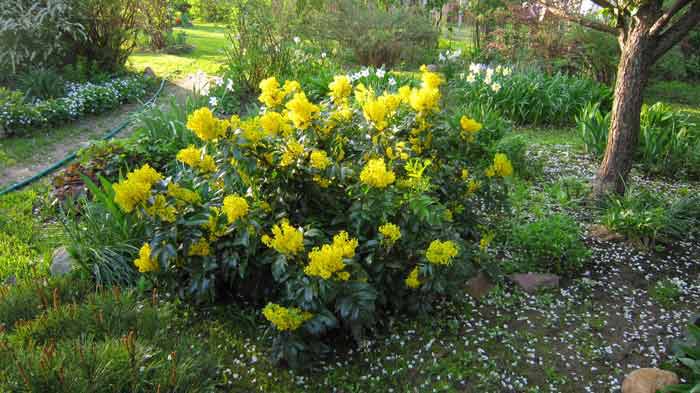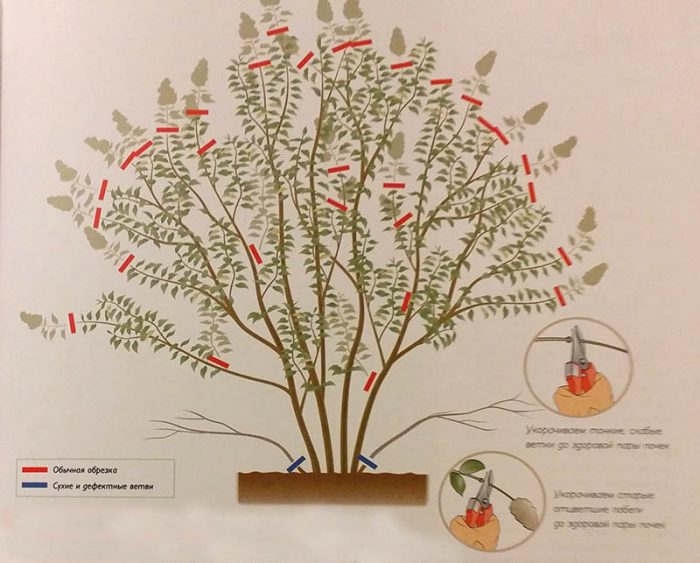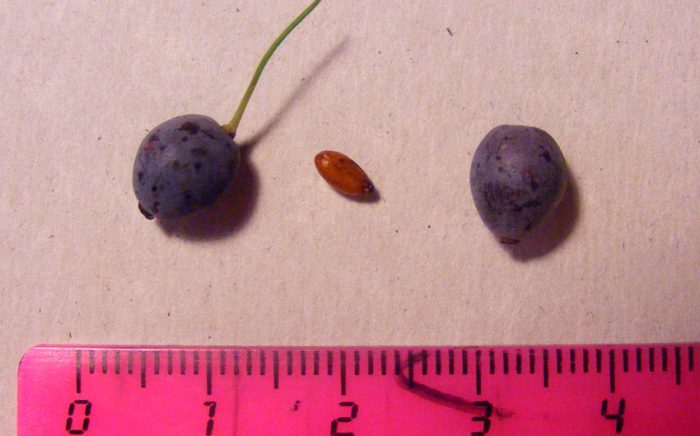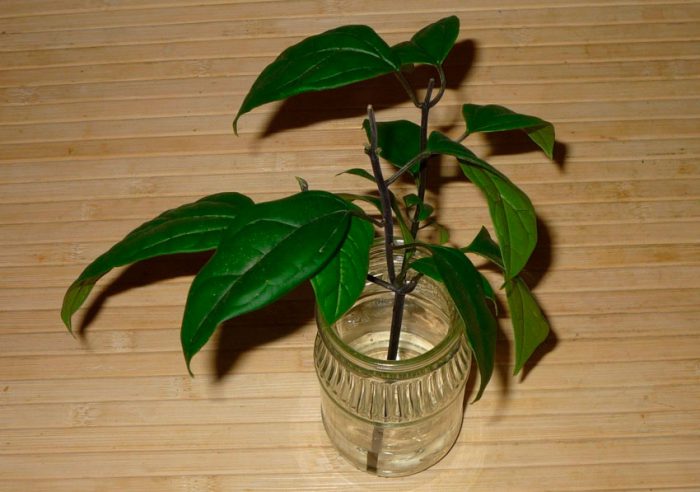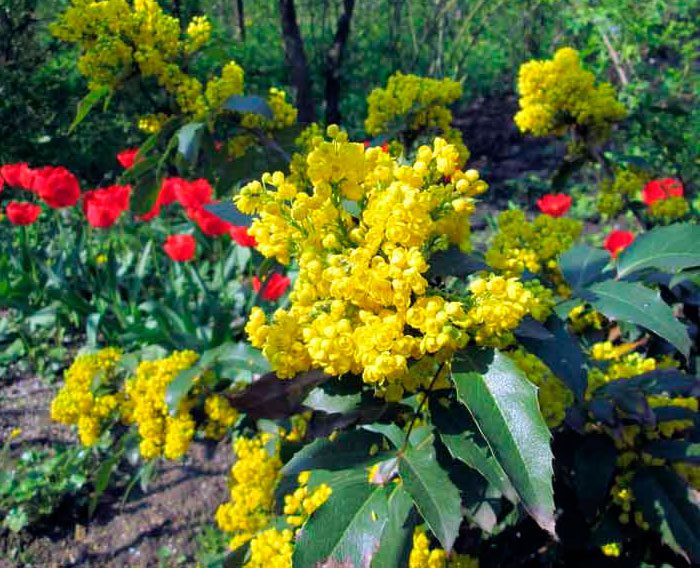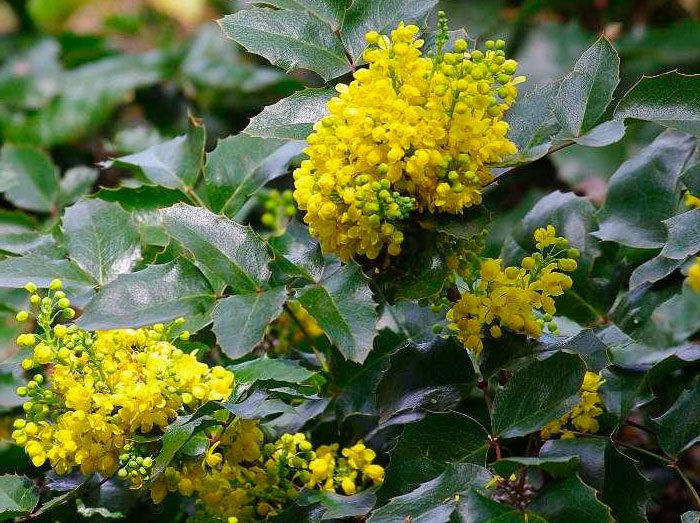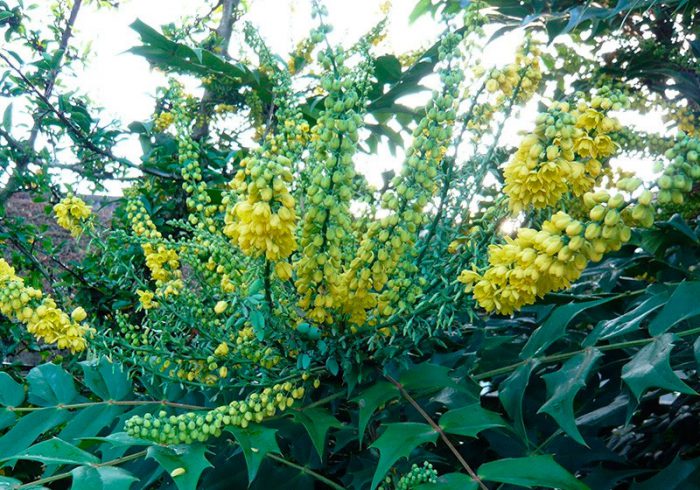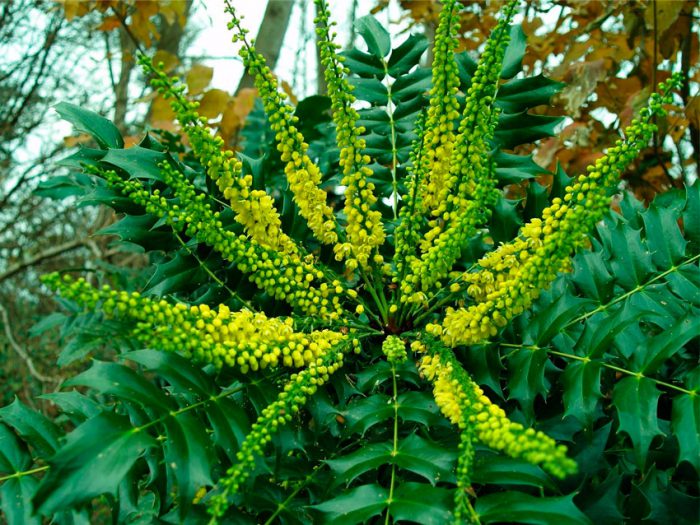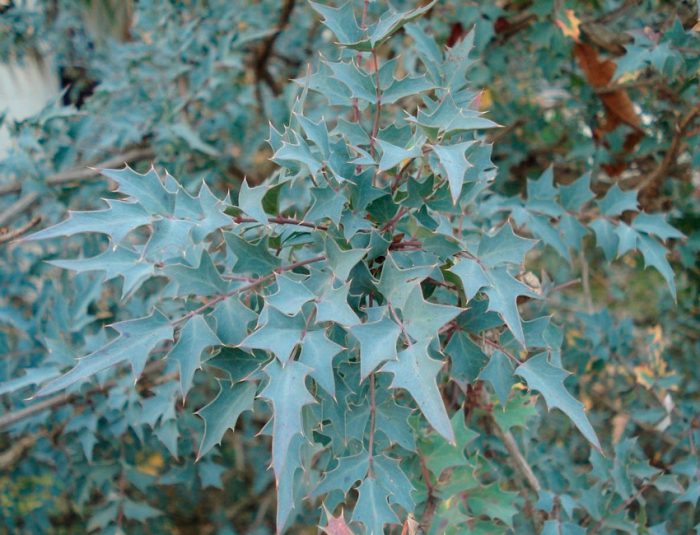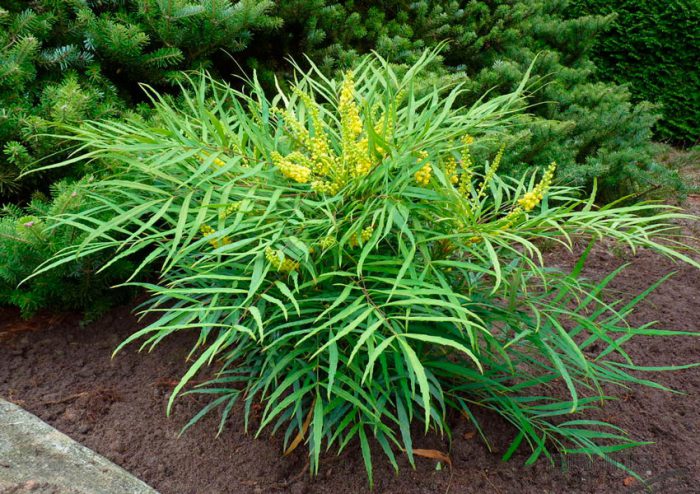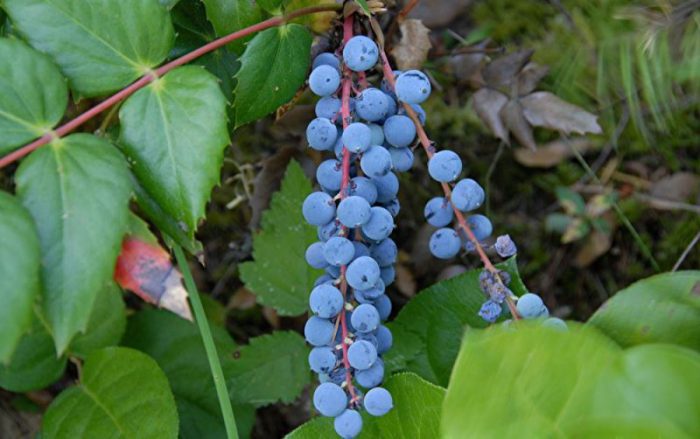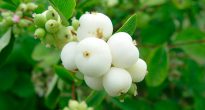The Mahonia plant is represented by shrubs and trees and belongs to the barberry family. Wild magic can be found in the eastern and central regions of Asia, as well as in North America. This genus was named after the American gardener from Ireland, Bernard McMahon, he was engaged in acclimatizing plants in the eastern United States, which he brought from the western part of the country. He also became famous for being the first to create the American garden calendar. This genus includes about 50 species. Mahonia holly is a type species of this genus, where it comes from, it is also called "Oregon grape". Such a shade-loving plant is highly resistant to frost and drought, as well as undemanding to the ground.
Content
Features of the Mahonia shrub
Mahonia is an evergreen shrub, reaching a height of about 100 centimeters. It has abundant root shoots. On old stems the bark is brown-gray, and on young stems it is grayish-pink. Unpaired complex leaf plates have light red petioles and consist of 5–9 sharp-toothed-notched leaves, which reach 15–25 millimeters in width and 3–9 centimeters in length. Such leaves are dark green, leathery, their front surface is shiny, and the back is matte. Multi-flowered axillary racemose or panicle inflorescences consist of bright, pale yellow flowers (sometimes with lemon tint), the diameter of which can reach 0.8 cm.The fruits are oblong-elliptical berries, painted in black and blue, on their surface there is a thick coating of bluish bloom, as well as a cannon. In length, such berries reach 1 cm, and in width - 0.8 cm, they have a rather pleasant sweet-sour taste and are used in confectionery production, and they also tint wines. Flowering occurs in April and May, while berries ripen in September or August.
In landscape design, this plant is used to create curbs, low hedges, group plantings, and it is also planted as a salt or used for tamping tall shrubs. In winter, shiny leaf plates change their color to green with a beautiful red tint. Also, this shrub looks very impressive during the ripening of the purple-blue berries, covered with a waxy bloom.
Growing Mahonia in the open field
What time to plant
Mahonia is planted in open soil in spring. In this case, before the onset of frost, the plant will take root well and begin to grow actively. However, many gardeners are quite successful in planting such a shrub in summer and autumn. Its planting should not be carried out only in late autumn and winter.
For landing, you should choose a well-lit area that has reliable protection from strong gusts of wind. Also, the shrub can be grown in a little shade, only in this case there will definitely not be a rich harvest of berries. When choosing a place for planting, it should also be taken into account that the direct rays of the sun can injure the delicate leaf plates of Mahonia, therefore it is best that the selected area be in the lacy penumbra of tall trees.
The soil must be necessarily loose, saturated with nutrients and high in humus. In order to fill the planting hole during the planting of the seedling, prepare a mixture consisting of humus, turf and sand (2: 1: 1).
Landing features
The preparation of the pit for landing should be done half a month before the planned landing date. The size of the planting pit should be equal to 0.5x0.5x0.5 m. In the event that the soil in the selected area is heavy clay, then the depth of the pit should be increased, since a drainage layer will need to be made at its bottom. After everything is ready, fill the hole ½ part with an earth mixture, the composition of which is described above. After 14 days, compaction and subsidence of this soil should occur. When creating a curb or hedge, a distance of 100 centimeters should be observed between the specimens. In the event that you create a loose planting, then the distance between the bushes should be equal to two meters.
Before planting a seedling, make a thorough examination of its root system, while it is necessary to remove dried and diseased roots, as well as shorten too long ones. Places of cuts should be sprinkled with crushed charcoal. When both the seedling and the planting hole are ready, you can start planting. For this, the root system must be placed in a pit, which is filled with earth mixture (its composition is described above). When planting, make sure that the root collar of the plant rises slightly above the soil surface. The earth in the near-trunk circle should be properly compacted, and a roller should be made of ten-centimeter-high earth around the perimeter. The planted Mahonia needs abundant watering, so 20 liters of water should be poured under each bush. After the liquid is completely absorbed into the ground, the surface of the trunk circle should be covered with a layer of mulch.
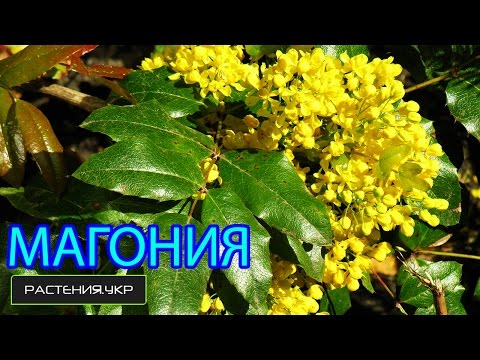

Watch this video on YouTube
Mahonia care
Caring for Mahonia is not much different from caring for other garden shrubs. Such a plant must provide systematic watering, timely feeding, weeding and loosening of the soil. Sometimes in the evening it will be possible to spray the crown of the plant with water. The first pruning is done after the age of the bush reaches 10 years. You also need to process Mahonia from pests and diseases as needed.
How to water
This moisture-loving plant especially needs abundant watering at a young age. After the seedling is planted, it is watered abundantly. When watering the shrub, do not forget to spray the crown with water.Watering is recommended in the evening, when there will be no more scorching sun rays. Adult specimens need watering, as a rule, only during the dry season, while this procedure must be performed twice a week, pouring 1 bucket of water under each bush. If it rains systematically, then it will be possible not to water the plants at all. The surface of the trunk circle must be loosened to a not very great depth the next day after watering or precipitation.
Top dressing
Top dressing of the shrub should be done twice per season, namely, at the very beginning of the spring period and in May, before it blooms. The plant is fed with mineral complexes, for example, Kemira-universal or Nitroammofoskoy. For 1 square meter, 100 grams of the nutrient is taken. In autumn, the surface of the trunk circle of Mahonia must be covered with a five-centimeter layer of mulch (humus or compost). In the springtime, you should dig up the soil along with mulch.
Transfer
This shrub can be transplanted throughout the growing season. However, it is better not to do this in late autumn, since with the onset of frost, the plant may die due to the fact that it did not have time to take root properly. Mahonia tolerates transplantation quite well, while this procedure should be performed in almost the same way as the initial planting.
Pruning
In early spring, before the buds swell, you need to make sanitary pruning. To do this, it is necessary to cut off all injured, damaged by disease, pests or frost, as well as dried and weakened branches. In order to maintain the splendor and compactness of the bushes, they must be cut after they have faded or in the autumn. At the same time, remember that the laying of flower buds occurs on last year's shoots, so they should be shortened by no more than ½ part. If the plant is already very old, then if desired, you can make anti-aging pruning, which the plant tolerates very well.
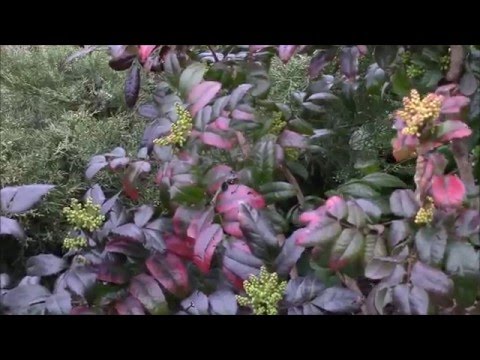

Watch this video on YouTube
Preparation for wintering
Since this plant is perennial, it must be prepared for winter. If Mahonia is grown in mid-latitudes or in Ukraine, then it will be able to overwinter without shelter. In the event that a very cold winter is expected with practically no snow, then it is better to cover the bushes with spruce branches. If the plant is still young, then experienced gardeners recommend, be sure to cover it with spruce branches for the winter.
Reproduction of Mahonia
Mahonia can be propagated by seeds, cuttings and layering.
How to grow from seeds
Seeds are sown in open soil in the autumn immediately after harvesting, while they should be buried in the ground no more than 20 mm. Sowing can also be done in spring, but in this case, the seeds will need to be stratified within 4 months at a temperature of 0-5 degrees. Newly appeared seedlings will need reliable protection from direct sunlight. In autumn, thinning or planting of seedlings in individual containers is carried out. After another 1–1.5 years, the seedlings can be transplanted into the open ground to a permanent place. Do not forget to cover the young plants with spruce branches and cover them with snow for the first 2 or 3 winters. Such a shrub, grown in a generative way, will bloom only at the age of four.
Cuttings
Cuttings are harvested at the very beginning of spring before the buds swell. Remember that there should be 6 buds on each cutting. The cuttings should be immersed in a container of water placed in the garden, with only ½ part of them in the liquid. After about 8 weeks, roots will grow from the buds that are at the bottom of the cutting. After the roots reach 7 centimeters in length, the stalk must be planted in open soil and covered with a plastic bottle on top, from which the neck is previously cut off.After 1.5 weeks, the bottles are left only overnight, and for the day they are removed, this will allow the plants to gradually get used to the new conditions.
How to propagate by layering
In the springtime, you need to choose a strong coppice shoot. It bends down to the surface of the ground, fits into a previously prepared groove and is fixed in this position. In this case, the top of the stem should remain above the soil surface. Then the groove must be filled with earth. When watering a shrub in the summer, do not forget about layering. The rooted cut can be cut off from the parent bush and transplanted to a new permanent place only next spring.
Pests and diseases
Mahonia has a very high resistance to diseases and pests. However, in some cases, such a shrub is affected by fungal diseases such as: rust, powdery mildew and spotting (stagonosporosis and phyllosticosis).
In order to get rid of powdery mildew, the affected shrub must be treated once every 10-12 days with a solution of a fungicide, for example, Topsin-M, Fundazol, Karatan, etc.
To cure Mahonia from rust, it should be sprayed with such fungicides as: Abiga-Peak, Oksikhom, Tsineb, Bayleton, etc.
If large spots of brown color appear on the leaf plates of a plant, this means that it is affected by phylosticosis. Pycnidia appear on the obverse of such spots. During the season, such a fungus is able to give several generations. Affected bushes lose their spectacular appearance, their leaf plates die off prematurely, flowering becomes less lush and productivity is significantly reduced.
If there are oval-shaped specks with a dark border along the edge of the leaf plates, this indicates infection of the bush with stagonosporosis. Rounded pycnidia appear on the front surface of the spots. The infected shrub first loses its spectacular appearance, and then dies altogether.
To get rid of spots, it is necessary to collect and burn all overwintered foliage in the spring. Then the shrubs are treated with Kaptan, Oxyhom or Ftalan. This must be done before sap flow begins.
Growing Mahonia in the Moscow Region
Mahonia should be cultivated in mid-latitudes in the same way as in regions with a less severe climate. This shrub has a high frost resistance, and therefore it is not afraid of frosty winters. But at the same time, it should be remembered that young bushes for the winter must be covered with spruce branches and covered with snow that has fallen so that a not very large snowdrift is obtained.
Types and varieties of Mahonia with photos and names
Creeping magonia (Mahonia repens)
The homeland of this species is North America, at the moment it is not very popular with gardeners. Such a shrub is outwardly very similar to holly mahonia. The bush in height almost never exceeds half a meter. The composition of the leaf plates includes from 3 to 7 ovoid-rounded pale greenish-gray leaves, they are leathery and have a sharp-toothed edge. Inflorescences of lemon-yellow color appear in mid-May, and then again in the last days of September. Ripening of berries ends in mid-August. This species has a higher winter hardiness compared to holly mahonia, but its appearance is not so spectacular. There are 2 decorative shapes:
- Round-leaved. The leaf plate contains 5 rounded leaves.
- Large-fruited.
Mahonia japonica
It is found naturally in Japan, America, China and Europe. Flowering is observed from the last days of December to early spring. Such a large bush can reach a height of 200 centimeters. It has an unusual and extremely effective shape. Its straight shoots stick out in different directions. It blooms with yellow racemose inflorescences, from which the aroma of lily of the valley emanates.
Mahonia Winter sun (Mahonia x media Winter sun)
This hybrid plant is the result of crossing Lomariella and Japanese Mahonia. The height of the bush is about 2 meters. In middle latitudes, such a hybrid is cultivated only in greenhouses, since its flowering is observed in winter.
Mahonia fremontii
This species is native to the west coast of the United States in height can reach 3 meters. The color of the inflorescences is light yellow, and the berries are purple-red. While the plant is young, its leaf plates have a purple hue, in an adult they are green shrubs, and in an old one they are gray-gray.
Mahonia bracts Soft Caress (Mahonia eurybracteata Soft Caress)
This spectacular Chinese plant has very graceful thin leaf blades. Typically, a container is used to grow this variety.
Mahonia neubertii
Such a semi-evergreen shrub is a hybrid; it was obtained as a result of crossing the common barberry and the holly mahonia. Such a rare plant has a very spectacular appearance. The shrub height does not exceed 100 centimeters. Oblong-ovate leaf plates are outwardly similar to the foliage of barberry. There are no spines on the stems.
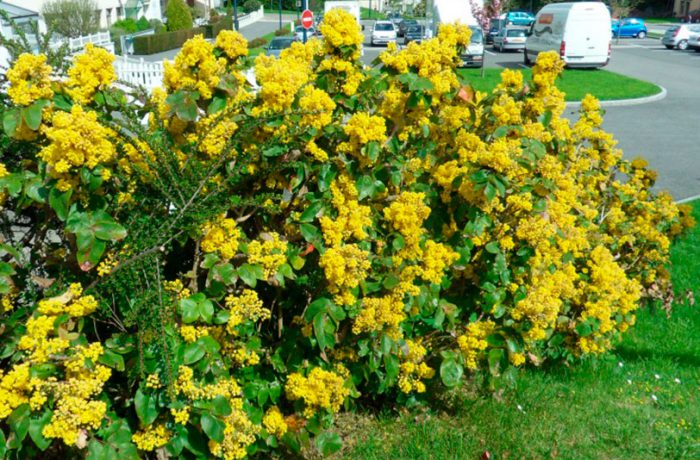

Such a common species as Mahonia holly has the following varieties:
- Nut-leaved... In this shrub, leaf plates, located on petioles of red color, include 7 leaves, which are somewhat denser and smaller than that of the main species.
- Graceful... The leaf plates of this variety are longer than the main species.
- Golden... The color of the foliage is golden yellow.
- Variegated. Multi-colored leaf plates.
The most popular are the following varieties of Mahonia holly:
- Apollo... The variety was obtained in 1973 in Holland. The height of a bush with a compact crown can vary from 0.6 to 1 meter. The length of the leaf plates is about 30 centimeters, they include from 5 to 7 leaflets with a sharp-toothed edge. In the summer, they are colored green, and in August they have a bronze tint. Fragrant flowers are painted in a rich yellow color. There is a waxy bloom on the surface of the black-blue berries.
- Atropurpurea... This variety is also obtained in Holland. The height of the bush and the diameter of the crown are 0.6 m. The color of the glossy leaf plates is dark green, they reach 25 centimeters in length. The color of the fragrant flowers is yellow. The berries are black and blue.
Properties of Mahonia - harm and benefit
Benefit
The fruits of Mahonia contain a lot of ascorbic acid, which helps to strengthen the immune system. If you just eat these fruits, you can strengthen the walls of blood vessels, improve the outflow of lymph and accelerate blood circulation. Also in Mahonia are tannins, different types of alkaloids and organic acids.
The fruits also contain berberine, which helps to protect the bone marrow and helps the body recover in a short time after a course of radiation and chemotherapy. Scientists from Australia have found that berberine is able to increase the activity of insulin, in this regard, it began to be used during the treatment of complex forms of diabetes.
The extract from the roots of this plant stimulates the choleretic function of the body, therefore it is used for gastritis, hepatocholecystitis, hepatitis, inflammation and blockage of the biliary tract and giardiasis. It is also used to eliminate edema, during the treatment of acne, eczema and herpes, and is also used to normalize the functioning of the digestive tract and restore the intestinal microflora. Also, the hood has an antibacterial and antiviral effect.
In the bark of Mahonia holly there are substances that are used in the treatment of psoriasis.
Contraindications
Means from Mahonia cannot be used during pregnancy and lactation, as well as for persons with individual intolerance to such a plant.Also, you can not use such funds for people with chronic intestinal upset, with ulcers and high acidity of gastric juice. The use of such drugs in some people can cause diarrhea and nausea, in this regard, before eating the fruits of mahonia or using products prepared on its basis, you should definitely consult with a qualified specialist.


Watch this video on YouTube

